1 Preparation of feeding Red Coffee Beans (Sort stage 1)
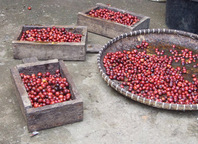 This quality coffee beans will be picked for the red course and really fresh, which would then be sorted to separate the rotten cherries by way of immersion, good coffee beans will sink in water, while the foul will float.
This quality coffee beans will be picked for the red course and really fresh, which would then be sorted to separate the rotten cherries by way of immersion, good coffee beans will sink in water, while the foul will float.
2 Feeding
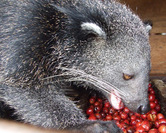 Red coffee berries which have been sorted out by soaking further distributed into containers to give to weasel / civet, in this case, farm in western Lampung using weasel / civet and binturong type in which of several existing types of weasel, only these two species are an eater of coffee
Red coffee berries which have been sorted out by soaking further distributed into containers to give to weasel / civet, in this case, farm in western Lampung using weasel / civet and binturong type in which of several existing types of weasel, only these two species are an eater of coffee
In this process, the ferret / mongoose is very important that the sense of smell will be used in sorting the cherries with the perfect level of maturity where civet / civet loves the sweet taste of cherries really mature.
Coffee beans are actually ingested subsequently undergo fermentation in the stomach which will further ferret reissued along with dirt (civet coffee)
3. Harvesting and drying civet coffee
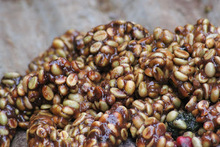
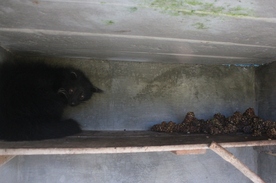 After harvesting, there are two options in the yield of dry beans with direct drying civet droppings (civet coffee wet) directly to produce dried dung of civet coffee (raw beans) or by washing prior to purify the coffee as recommended by the MUI for later diijemur and produce grain of civet coffee.
After harvesting, there are two options in the yield of dry beans with direct drying civet droppings (civet coffee wet) directly to produce dried dung of civet coffee (raw beans) or by washing prior to purify the coffee as recommended by the MUI for later diijemur and produce grain of civet coffee.
(for purification by direct drying method to produce raw beans will be explained later)
4. Milling and selecting the beans (sort phase 2)
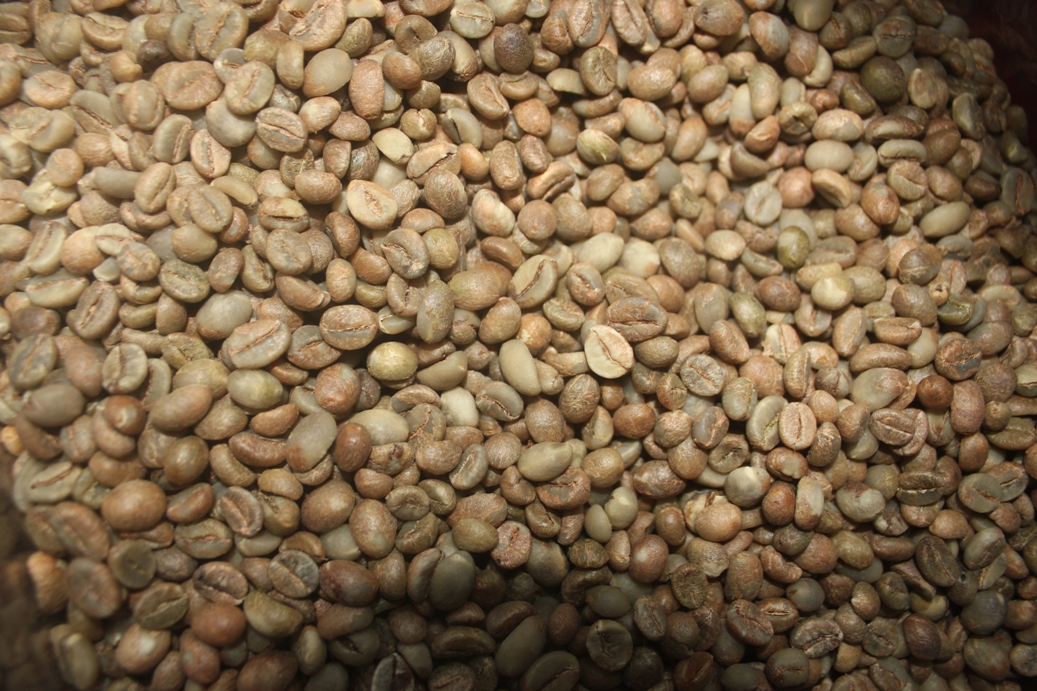 After the drying process the raw product is then produced civet coffee beans or grain, the next process is grinding, then once finished in milled, the beans will be selected and sorted to separate the coffee beans intact and ruptured by grinding coffee beans or spoilage during drying, this sorting process is done manually to produce coffee beans ready to fry quality (greenbeans)
After the drying process the raw product is then produced civet coffee beans or grain, the next process is grinding, then once finished in milled, the beans will be selected and sorted to separate the coffee beans intact and ruptured by grinding coffee beans or spoilage during drying, this sorting process is done manually to produce coffee beans ready to fry quality (greenbeans) 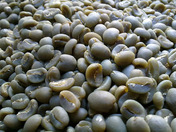
5. Peaberry Luwak, the rarest coffee beans in the world (the sorting phase 3)
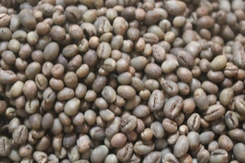 Do you know the rarest coffee beans? Yes civet coffee peaberry or commonly called lanang in the Java language, why rare? In addition to the coffee bean is derived from the beans which in its manufacture requires a long process with a limited amount, mongoose peaberry is sorted manually to get a single coffee beans from thousands of items of the beans that have been dried, the amount of coffee beans is very limited.
Do you know the rarest coffee beans? Yes civet coffee peaberry or commonly called lanang in the Java language, why rare? In addition to the coffee bean is derived from the beans which in its manufacture requires a long process with a limited amount, mongoose peaberry is sorted manually to get a single coffee beans from thousands of items of the beans that have been dried, the amount of coffee beans is very limited.
6. Sanctification - frying the beans (Roasting)
 For Muslims, permitted are important things that must be considered. Previously I have mentioned about the cleansing that can be done in two versions namely the direct purification by washing impurities as described in the manufacture of civet coffee grain.
For Muslims, permitted are important things that must be considered. Previously I have mentioned about the cleansing that can be done in two versions namely the direct purification by washing impurities as described in the manufacture of civet coffee grain.
then how the cleansing is done if the process of making through the process of making raw beans? The answer is 7x washing done, one of which in the mixed soil as guidance in Islamic law prior to frying pan (roasting).
You can choose a variety of frying roasting character according to your taste with a certain minimum order
7. Pulverization Packaging
 Pulverization process can be done by hand using a pestle is the traditional language called dimples or done in a modern way using the tool, after civet coffee powder is obtained, then be packaged by using aluminum foil, use of packing with aluminum foil can keep the freshness of the coffee is good quality and maintain the durability of the coffee aroma is the relatively long time.
Pulverization process can be done by hand using a pestle is the traditional language called dimples or done in a modern way using the tool, after civet coffee powder is obtained, then be packaged by using aluminum foil, use of packing with aluminum foil can keep the freshness of the coffee is good quality and maintain the durability of the coffee aroma is the relatively long time.


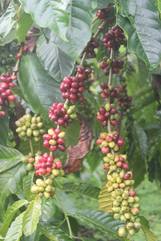
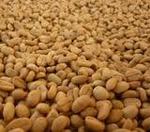

No comments:
Post a Comment
THANK YOU BEEN READING MY BLOCK, PLEASE LEAVE COMMENTS